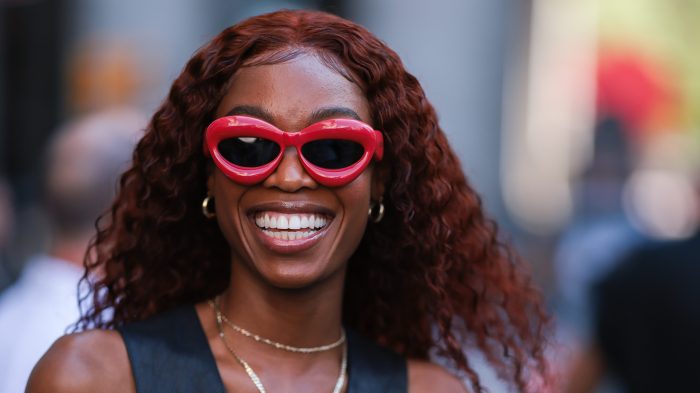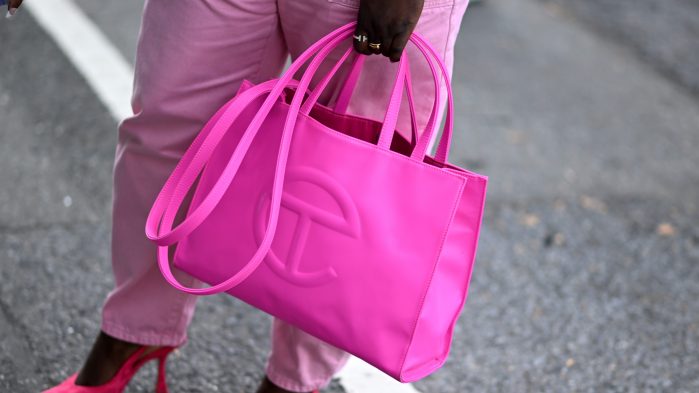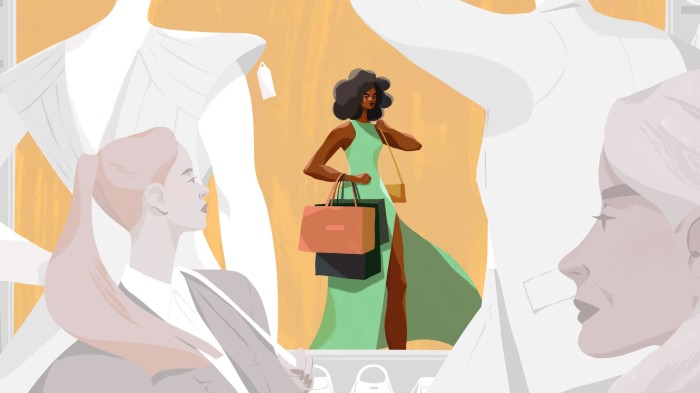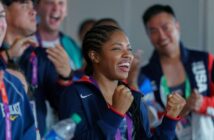The cost of luxury is higher for Black women.
Not because the actual price goes up when a Black woman walks into a designer boutique. But because Black consumers also have to add in the cost of a brand’s anti-Black history.
The way we adorn ourselves has what Mark-Evan Blackman, chair of the fashion design department at the State University of New York, Korea, calls a “citizen component.”
“That’s a calculation that people of color, and largely women of color, have to make regularly,” said Blackman. “Every other customer purchasing that garment, that piece, doesn’t have to worry about anything other than their bottom line.
“Our bottom line is multifaceted,” Blackman said. “It includes socioeconomic levels, the way your cousin was treated in the store when he walked in, lack of service, a snub. Our bottom line has to quickly calculate: ‘Is this what I want to do?’ realizing that we also want to look good. The pull of what got us into the store hasn’t diminished, although all these other factors might contribute to our decision.”
The #SoftLife isn’t as easy as it looks onlineRead now
So often the weight of a brand’s wrongdoing lands on Black women, leaving us to add it to the calculation of whether our desire for a high-status item gives us status.
Start with the history. Brooks Brothers profited from outfitting enslaved people, their enslavers, and then Union soldiers during the Civil War. Designer Coco Chanel was a Nazi informant. Daimler AG, which makes Mercedes-Benz, used forced labor, including prisoners of war and concentration camp inmates, to build vehicles for the German military.
And it’s not like all of the white supremacy is in the distant past. Dolce & Gabbana, despite a history of racism and anti-gay bias, is still dressing Black celebrities for award shows. Balenciaga and Gucci, two brands that have incredible cultural currency with Black customers, have been called out repeatedly in recent years for appropriating or mocking Black culture.
At times, it felt like Balenciaga and creative director Demna Gvasalia have been trolling its customers since he joined the fashion house in 2015. His debut runway show didn’t feature a single Black model. His early contributions to the brand included an $895 airbrushed hoodie and $1,500 plastic Chinese slippers. In 2017, Swizz Beatz accused him of stealing the Ruff Ryders’ logo.
In November, Balenciaga apologized on Instagram for its holiday marketing campaign, titled Balenciaga Gift Shop, featured children holding teddy bears that were dressed in bondage accessories. A separate campaign, called Garde-Robe, showed a Balenciaga handbag photographed next to documents from the Supreme Court’s 2008 decision in U.S. v. Williams, which held that the promotion of child pornography did not violate the First Amendment.
The Internet was enraged and called on Black celebrities such as Cardi B to speak out against the brand because she once rapped “I like those Balenciagas/ the ones that look like socks.” Some fashion influencers were even going so far as to destroy items they had purchased.
Balenciaga’s latest controversy made Chanel Tyler, a global lead for creator partnerships at YouTube and a skin care enthusiast or “skinthusiast” who often shares her shopping picks with her 26,000 followers on Instagram, decide to pause on adding any new Balenciaga pieces to her wardrobe.
“Look at Balenciaga right now,” said Tyler. “They are being scrutinized in the media for making some very poor decisions and clearly not fully understanding the impact of what was happening.” She was saving up to buy a pair of silver Balenciaga boots. But after the latest controversy, it doesn’t feel right to purchase them.
On her own social media, Tyler often shares her style purchases, a mix of high-end designer items with lower-priced pieces. She inherited her first luxury piece, a mini Chanel flap handbag, from her mother as a college graduation present. “I did grow up seeing my mom as a luxury consumer. She worked really hard, but she was also very much a fan of treating herself for her hard work.”
Now Tyler, who is named after her mother’s favorite designer, says she shops based on need, filling the gaps in her wardrobe and where she can get the best deal. She wants to support brands that she believes support her and her community, and says it’s not always that simple.
Gucci was called out for its “homage” to designer Dapper Dan when the Internet noticed then-creative director Alessandro Michele’s bomber jacket from the 2018 cruise collection was nearly identical to a piece the Harlem designer produced in the 1980s.
After Gucci was called out again, this time for a balaclava resembling blackface makeup, the brand instituted its Changemakers Council in 2019 to “invest important resources to unify and strengthen our communities across North America, with a focus on programs that will impact youth and the African-American community.”
 The streets have spoken: Loewe’s cat-eye sunglasses are the must-have of the momentRead now
The streets have spoken: Loewe’s cat-eye sunglasses are the must-have of the momentRead now
Designers and brands are under constant scrutiny thanks to social media’s 24-hour cycle. And after 2020’s global racial reckoning, we’re revisiting how the brands we buy into show up in the world.
For instance, when Beyoncé starred in the ultimate visual of Black women living a soft life for Tiffany & Co., she faced backlash for wearing a $30 million blood diamond, even though the jewelry brand promised to give $2 million for scholarships at historically Black colleges and universities.
Tina Knowles-Lawson responded to the criticism of her daughter in an Instagram comment, writing “How many of you socially conscious activists own diamonds? I thought so! Well guess what did you go to try to check to see where the diamond came from? Probably not!”
The pressure placed on Black women to stop supporting brands who have had controversy annoys Yinka Animashaun, a fashion enthusiast who inherited her first designer bag, a Fendi baguette, from her mother in the eighth grade.
“I’m nobody’s mule. I’m definitely sensitive to missteps but I’m not burning items I’ve already purchased or anything like that,” Animashaun said. “Depending on what is done, I’ll take my coins elsewhere.”
Tyler agreed. “It ebbs and flows, there are brands that have been able to make a comeback from things like that,” she said. “It just takes time and you have to see them actually putting their money where their mouth is. You’ve got to see them actually executing and following through and doing what’s right.”
This is a new dilemma for many Black women, who now have the disposable income and leisure to indulge in high-end, name-brand shopping. For their mothers and grandmothers, whose clothes shopping was mainly for necessities — back-to-school outfits, work uniforms, comfortable shoes to withstand a long workday — it was a straightforward calculation to determine whether the item was worth buying from a store that treated you poorly. Now, the moral calculus asks if you feel comfortable spending thousands of dollars on beautifully made things by a company that either is casually racist or has a sordid history.
“You can come home with something that someone is truly offended by,” said Blackman. “Aesthetically, you love it, and aesthetically they get it, they love it too. But they would never be seen wearing it.
“There is a new awareness of product, product history, the company’s history that one has to be armed with before they go and shop. That is everyone’s new reality, especially people of color.”
For a previous generation, these issues of access to high fashion and its meaning for one’s social status were encapsulated in Ebony Fashion Fair.
Eunice Johnson, the co-publisher of Ebony magazine, started Ebony Fashion Fair in 1958. At the time, Black society was still going to the dressmaker and women in general sewed in much larger numbers.
“But when they saw Ebony Fashion Fair, it redefined their awareness of fashion, their perspective of fashion and how big fashion was,” said Blackman.
The show started as a fundraiser but grew into the world’s largest traveling fashion show. Its success marked a shift not only in Black women’s access to luxury fashion but our power as consumers. And because Fashion Fair went on for decades, until 2009, generations of people were raised seeing this quality of fashion. If you didn’t see it at the show, you saw it in Ebony magazine.
So often the weight of a brand’s wrongdoing lands on Black women, leaving us to add it to the calculation of whether our desire for a high-status item gives us status.
Audrey Smaltz traveled with Ebony Fashion Fair from 1970 to 1977, providing the commentary for the runway appearances by the models. In the beginning, it wasn’t easy for her and Johnson even to get in front of designers to see their clothes.
“In the 1970s, not every designer wanted us to come to their fashion show. They weren’t very generous to Ebony magazine,” Smaltz said. “I used to tell them that our subscriptions were three times the amount of people that read Vogue, read Ebony. We had millions of people that ordered and subscribed. Vogue didn’t have that many but, you know, it’s Vogue.”
Smaltz said because she was tall and thin — “Black models were the rage in the ’70s” — she was able to sneak backstage at the runway shows they weren’t invited to and tell Johnson which pieces to buy for the Ebony Fashion Fair.
“Eunice bought the top clothes from the top designers when I was with her,” said Smaltz. “We bought clothes from Hubert de Givenchy, Pierre Cardin, Yves Saint Laurent, you name it, Emanuel Ungaro, and in Italy we bought from Valentino Garavani.
“It wasn’t something that they were going to loan us. We bought those clothes. The Johnsons, you know, we had the money and no one else was doing this.
“They were getting to be more open in the ’70s because the Ebony Fashion Fair started in 1958 and we would go in there and some people just didn’t understand. ‘Oh, my God, you’re buying this? Oh, I don’t think you can sell it.’ But we just stayed right on it. We never gave up. And after a while they realized, you know, that the checks cleared.
Johnson had to write the checks before the gowns were delivered because she was buying couture and the designers needed the money to make the pieces. In the middle of the ’70s, Smaltz said, they added ready-to-wear.
 Telfar brings the rainbow to BrooklynRead now
Telfar brings the rainbow to BrooklynRead now
“They didn’t want to sell us ready-to-wear so I spoke up,” she said. “I said, ‘Yes, we’re going to buy your ready-to-wear, we buy your couture, we want your ready-to-wear.’ Eunice bought from everybody and after a while, they were just looking forward to selling to her because they knew if she showed up, they had a sale.”
Even though the fashion in Ebony was the best of the best, it was hard getting advertisers to see the value in having their brands on the pages of a Black magazine.
“When I wasn’t doing Ebony Fashion Fair, I used to sell advertising pages [for the magazine],” said Smaltz. “Mr. Johnson had me working, honey! I’ll never forget one of the top managers, his name was Howard Smith. He was trying to get Revlon to advertise with us. He asked me to come with him to present to Mr. Charles Revson [Revlon’s founder]. Mr. Revson was so nasty. You know what he said? ‘I don’t need to advertise in Ebony. Black women are still going to buy my nail polish.’ ”
Revson’s attitude illustrates the tension we see now all the time between high-end brands and their consumers, particularly Black women. Revson knew that Black women didn’t have many options in terms of nail varnish at the time. But Black women who shop luxury today know it’s their money and cultural cachet that give these brands relevance.
“The Black luxury consumer is a significant consumer of luxury brands,” said Tyler. Before her job at YouTube, she worked in marketing for the Estée Lauder Companies.
“We see that in all of the different culture genres that we propel. Black consumers spend a lot of their money on luxury goods. It’s just like always making sure that you are comfortable giving your money to this brand … Do you feel good about that purchase?”
What Tyler is saying is key to how Black women approach luxury shopping. We can’t rely on brands or their diversity initiatives to always get it right.
“A lot of luxury brands are family-owned and if they aren’t family-owned, the folks who work at the top and be decision-makers still don’t look like us,” Tyler said.
Luxury houses need not only inclusive leadership teams but inclusive boards that can ensure brands are not only working with folks who are representative of their customer base but also ensure that the customer base reflects the world.
These brands may have “inclusive” moments here or there but Animashaun thinks they’ll go back to “the usual white, skinny and wealthy audience they like to cater to. And Black women will decide if they still want to buy like we always have.”
“There’s still quite a bit of work to do and I don’t see anything significant changing in the next few years,” Tyler said. “It’s going to take some time just because … we haven’t been in those seats long and these businesses are very old.”
Channing Hargrove is a senior writer at Andscape covering fashion. That’s easier than admitting how strongly she identifies with the lyrics “Single Black female addicted to retail.”



